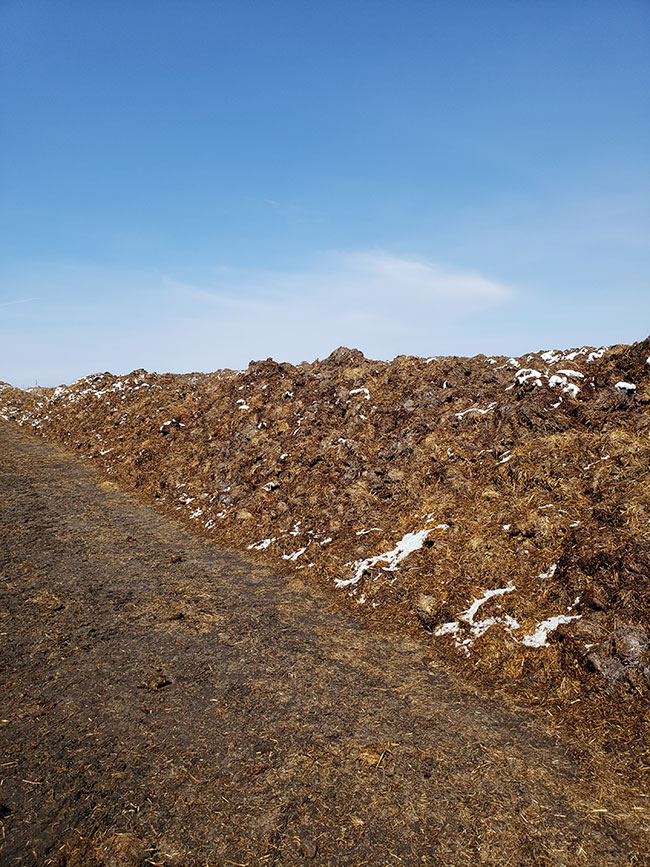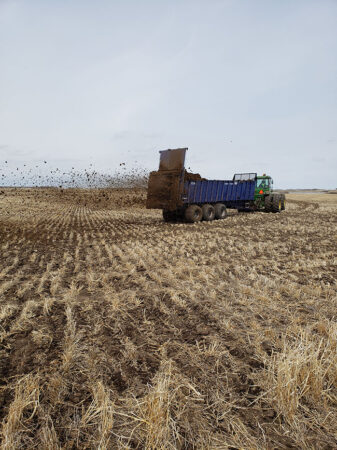
Features
Applications
Beef
Dairy
Precise is nice
University of Saskatchewan’s Jeff Schoenau shares lessons learned from research on precision manure management.
May 7, 2024 by James Careless
 Manure used as part of the Beef Cattle Research and Teaching Unit study.
All images courtesy of Jeff Schoenau
Manure used as part of the Beef Cattle Research and Teaching Unit study.
All images courtesy of Jeff Schoenau Science has proven it: Taking a ‘one size fits all’ approach to manure application is not the best way to stabilize crop yields and reduce nutrient runoff from manure applied to fields. Instead, a precision approach to manure application that takes a field’s unique characteristics into account and uses this data to regulate the dosage delivers the best results.
This truth was clearly demonstrated in a multi-year ‘Precision Cattle Manure Management’ study conducted at the University of Saskatchewan Livestock Forage Center of Excellence near Clavet, Saskatchewan. The field research was from 2018 to 2022, with the aid of numerous research partners across university and government.
“Our goal was to evaluate the agronomic and environmental performance of precision variable rate application of cattle manure with set-back from water bodies, compared to traditional constant rate application,” says study co-lead Jeff Schoenau, professor of soil fertility and at the University of Saskatchewan.
“I’ve done quite a bit of work in the past with liquid manure and ways of using it more effectively, including injection into the soil. And with the opening of the Livestock Forage Centre of Excellence with the Beef Cattle Research and Teaching Unit at the U of S here around 2018, we had the opportunity to obtain a manure applicator that had variable rate capabilities. So that led to the development of a proposal and the onset of the project.”
The reason Saskatchewan is so interested in precision manure application is the variability in this province’s soils. Factors that cause this variability include landscape and parent material variations that cause fluctuations in available nutrient and organic matter content in the province’s farm fields. Since cattle manure adds both organic matter and nutrients to these fields, “we theorized that there would be a benefit in applying more cattle manure to those areas of the test field that were lower in organic matter and low in nutrients, while cutting back or eliminating application in those parts of the field that already had plenty of organic matter and high levels of available nutrients,” says Shoenau, who is also the Saskatchewan Ministry of Agriculture soil nutrient management chair in USask’s department of soil science, College of Agriculture and Bioresources. “So that was the strategy that we took – comparing a traditional manure application where you just apply a constant rate across the field to a precision approach where manure application is varied across the landscape. Another part of our precision cattle manure application treatment was that we employed setbacks from areas in the field where water would accumulate from spring snowmelt runoff or heavy rains. Those were areas of the field that we did not apply any manure at all.”
The study
According to the Saskatchewan Soil Information System (2019), the field chosen for the precision manure application study is primarily composed of Bradwell Orthic Dark Brown chernozemic soil with Bradwell Eluviated Dark Brown chernozems on its lower slopes. It was split into three zones of approximately 40 acres to provide comparative data, with each zone having three replicate micro-watersheds. One zone underwent only commercial fertilizer applications to serve as the study’s control. The second zone experienced conventional constant rate manure application across the entire landscape, and the third underwent variable rate precision manure application with setback from watershed basin centers.
The manure applications for the constant and variably treated fields were done in spring 2019 and spring 2021, after the snow had melted but before the fields were seeded with silage barley. Water samples were collected from the watersheds prior to treatment in 2018 and 2019, and afterwards in 2020, 2021 and 2022.
According to the final report on the project filed with the province’s Ministry of Agriculture (‘ADF 20170025 Precision Cattle Manure Management For Agronomic and Environmental Benefit at the U of S Beef Cattle Research Unit’), the functional goal of the cattle manure application rate used in the study was “to meet the anticipated phosphorus requirements of silage barley grown on the field over the study period”.
To achieve this goal, “We used 40 acre zones for each of our treatments,” says Schoenau. “Our dosage prescription was pretty simple: Where we had areas of low long term productivity identified by Echelon NDVI imagery of the field, we applied higher rates of manure, and where we had areas of high productivity like in the depressional areas, we cut back. So we were putting generally more manure on the knolls, cutting back in the depressions and eliminating manure application in the watershed basin centers in our precision variable rate treatment.”
The subsequent measurements that were taken to compile data and support conclusions included silage barley yield and nutrient uptake, soil nutrients, phosphorus, nitrogen and coliforms in run-off water, greenhouse gas production, soil carbon and nitrogen amount and cycling, and any hormones found in the soil, water and manure.

A barley field that was used as part of the study.
The findings
According to the precision manure application study’s final report, “The total silage barley yield, nitrogen and phosphorus uptake over the five years was similar among the three treatments, but with variable rate manure treatment resulting in more uniform production across the landscape.” In other words, tailoring the manure dosage to the ‘lay of the land’ ensured that all areas delivered consistent barley yields.
At the same time, “Post-harvest surface soil nitrate and phosphate levels were lower in low slopes and depressions of the variable rate treatment zone,” said the report. “This was consistent with the observed slightly lower amounts of soluble P [phosphorus] and N [nitrogen] in runoff water observed in the variable rate treatment compared to constant rate. Soil nitrate levels at 30-60cm and 60-90cm depth were greater in the constant rate treatment zone than the variable rate and commercial fertilizer zones, which may reflect the observed additional mineralization of manure organic N to nitrate in depressions without set-back followed by leaching by spring snowmelt run-off. No phosphorus or nitrogen loading was evident from the manure applications after five years.”
Worth noting: Both constant and variable manure applications “did not have a large effect on nutrients and coliform bacteria in snowmelt runoff when compared to the inorganically fertilized control,” the report said. “The E-coli in snowmelt was not affected by manure application but rainfall-generated runoff in 2019 and 2021 following manure application had elevated counts of the pathogen.”
As well, there were lower nitrous oxide emissions “observed in the basin centers of the large catchment area watersheds in the variable rate treatment compared to traditional constant rate [treatment],” said the report. “The variable rate manured watersheds were also a stronger CH4 [methane] sink than the constant rate manure watersheds.” Not surprisingly, total soil nitrogen mass was boosted in both manured zones compared to the control zone, while neither showed any “measurable hormonal concentration [that] could be detected in soils or snowmelt water in any treatments.”
The bottom line: “Overall, the variable rate precision manure application strategy appears to provide agronomic and environmental benefits compared to traditional constant rate manure application,” the report said. In plain language, adjusting manure application rates to reflect field characteristics is good for crop yield and for the environment.

An example of solid, variable rate manure application.
The implications
With hard data like this at hand, it seems obvious that farmers who adopt the precision manure application approach can expect more consistent crop yields and reduced environmental impacts on their fields.
These results came as no surprise to Schoenau. “Low lying areas of fields on the prairies often have quite high organic matter and fertility to begin with,” he says. “So they generally don’t need too much more organic matter and nutrients added, whether it’s manure or fertilizer. Meanwhile, that smoothing out of production across the field area can offer some benefits in improved harvestability of crops. Then there’s the environmental benefits that we see from this as well.”
The overall conclusion is that precision manure application delivers the results that one would hope for, on all fronts. This is why farmers who apply manure to their fields will want to consider adopting this approach themselves. •